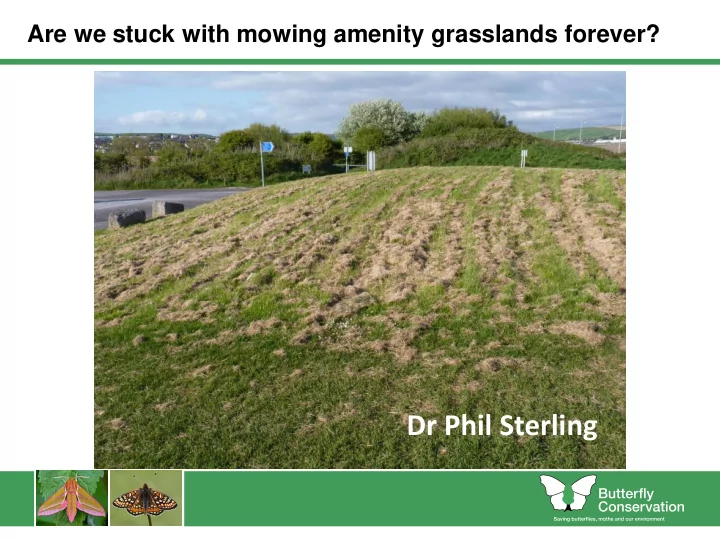

Are we stuck with mowing amenity grasslands forever? Dr Phil Sterling
An ecological approach to amenity grass management If we can control the amount grass grows in the first place, • we will have less to cut If we have less to cut, mowing should cost us less, and we • can spend more time on other jobs, and There will be more biodiversity because more species thrive • in poorer soils Response to austerity; ‘Climate Emergency’; C -reduction • targets; topsoil conservation; response to public awareness
Can we control the factors that make grass grow? Rainfall – no control Sunshine – no control Temperature – no control Soil fertility – we can control
What does soil fertility do to grassland? Thick topsoil Thin topsoil / no topsoil – coarse grasses dominate – fine grasses & herbs – high fertility – low fertility – few gaps for germination – plenty gaps for germination
Happy coincidence Our best grasslands for wildflowers, bees and butterflies develop on the poorest soils Lots of plants are able to compete for what nutrients are available Coarse grasses can’t dominate
Construction: Weymouth Relief Road, Dorset 2009 – 2011
Low fertility verges designed in 15mm topsoil or no topsoil Wildflower seed hand sown
2013
2019
Grassland management - 2 systems Mow & leave arisings – lots of Cut & collect – fine grasses, coarse grasses, few wildflowers lots of wildflowers
The Grillo: ideal for cut-and-collect in urban areas Grillo FD2200 (Hydrostatic Out-front Mower)
Establishing wildflowers in amenity grass - reduce fertility first 3 x cut & collect in 2017 reduces coarse grasses and favours fine grasses - this is mid-May in 2018
Disposal on site
Disposal out of town on highway land, hidden in the bramble thickets
People now see common wildflowers on urban grasslands on their way to work or the shops. These wildflowers support insects such as common butterflies and bumblebees. Previously this verge was mown 5 times a year and supported almost no wildlife at all
Once regularly mown amenity grass, cut-and-collect started 2017, seeded in autumn 2017, now wildflower meadow in 2019
Typical urban verge in Blandford after 2 years cut/collect
A354 Blandford Bypass verges County Wildlife Site after 5 years cut-and-collect
Let your community know what’s happening
North Dorset verges cut by DCC staff – just 2x in 2018
The annual budget for highway verge management at Dorset Council is reducing year-on-year based on adoption of an ecological approach
Taking an ecological approach - conclusions • If we reduce the amount grass grows in the first place there’s less to cut, and • We mirror natural conditions for flower-rich grasslands • Low fertility can be achieved by design & management • Saves money / staff can be redeployed more usefully • The ecological approach will deliver a buzz in our towns & cities on any amenity grassland at any scale
Recommend
More recommend